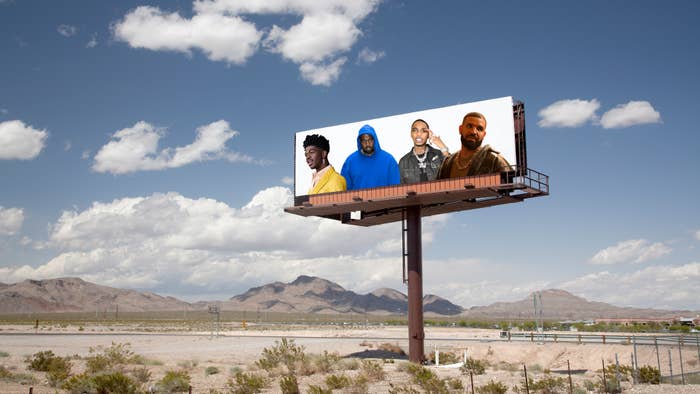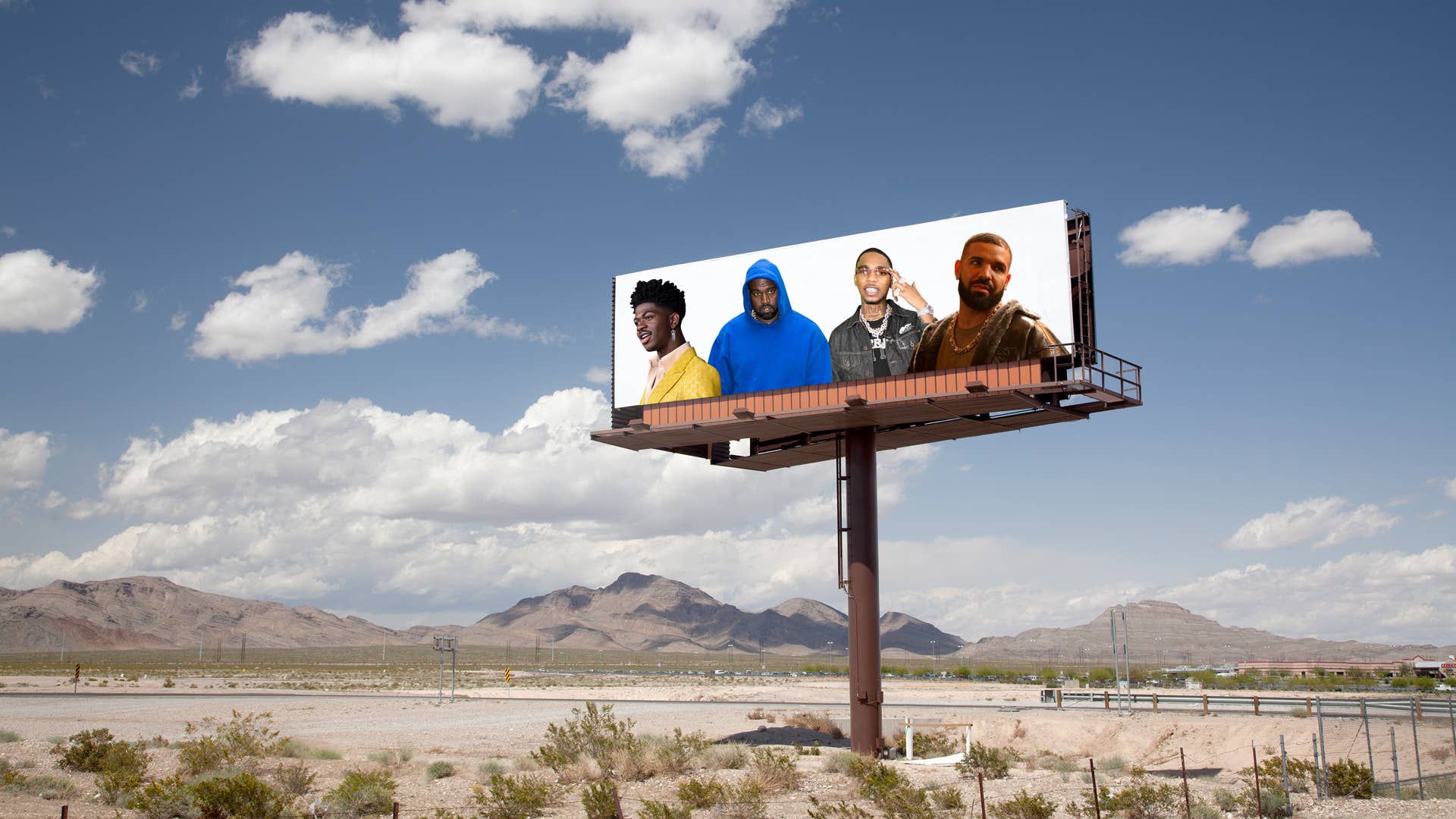
If you happened to be driving through a busy intersection in a major American city this September, you might have seen a cryptic message from Drake. Leading up to the release of Certified Lover Boy, dozens of billboards began popping up around the country, dropping hints about who would be featured on the album.
“Hey Toronto, the best rapper alive signed me in 2009 and is on CLB,” one message read, referring to Young Money’s Lil Wayne. Another billboard near New York City’s Times Square read: “Hey New York, the GOAT is on CLB.”
Just in the past few months, we’ve seen billboard campaigns from artists like Drake, Kanye, Lil Nas X, and Key Glock go viral online. Artists and labels have been using billboard marketing for decades, but the tactic has evolved over time. Now, in the social media era, billboards can reach a lot more people than just those who happen to be in the same physical location as the sign. If executed correctly, photos and videos of the billboards can spread quickly online, going viral and reaching millions of people across the world.
To understand the evolution of billboard marketing in music, you have to go back to the beginning. Jac Holzman, founder of Elektra Records, is credited as one of the first to popularize the advertising method in music. After The Doors finished their debut self-titled album in 1966, Elektra Records was looking for ways to put the emerging group on the map. After some brainstorming, Holzman picked a location near the Chateau Marmont hotel on Sunset Boulevard in Los Angeles and inquired with an ad company about a billboard to advertise the new band. Just like that, for $1,200 a month, Holzman reserved a billboard for the entire year.
“I wanted artists and DJs and writers to know that we were here,” Holzman tells Complex. “If you are a DJ or if you are a program manager, you get tons and tons of stuff on your desk every day, and it’s going to get lost. I thought this would call their attention, because they can’t help but see it. They’ve got to see it as they drive to or from work. Because they’re in a car, they’re paying singular attention, and we had an opportunity, if only a few seconds, to let them see and absorb it.”
The Doors’ billboard was an instant success. Holzman says he received calls from “several record salesmen” who were intrigued by the band, and many inquisitive bystanders went out and played the band’s music. Other labels took note, too, and billboards soon became an important part of any album rollout.
The same method that Holzman used for The Doors’ first billboard is still alive today, but it’s gone through some changes in the digital age. The rise of online marketing once threatened to render physical advertising obsolete, but some forward-thinking companies have figured out how to make billboards even more impactful in the social media era.
A few years ago, Spotify started its New Music Friday billboard campaign. Every Friday, a digital billboard in the center of Times Square highlights five different artists, ranging from global artists like Ariana Grande to rising stars like Jelani Aryeh. The initial goal was simply to show support for musicians in creative ways, but Ashley Graver, global head of creative artist partnerships at Spotify, says that the billboard campaign has exploded on social media because fans and artists excitedly post photos of the signs. Getting a Times Square billboard is a pivotal moment for an artist, and news quickly spreads on social timelines.
“It’s really a big moment on release week on our platform for every artist,” Graver explains. “I think what has become of bringing the billboard back and making it engaging is that artists really have started to go out of their way when they come visit New York. Times Square will be one of their first stops. At 12 a.m. on release day, they’ll go when the billboard is live. Sometimes fans show up. We’ve seen artists cry because these billboards really evoke all the emotions and it’s always been a real milestone for all the hard work these artists do.”
When Jelani Aryeh saw his Spotify Times Square billboard for the first time in July, he excitedly shared the moment with his fans on Instagram, writing, “OH WOW I THINK MAY JUST LEAVE MY BODY RN. WOW. WOW. WOWWWW. NEVER DID I EVER EXPECT SOMETHING LIKE THIS TO HAPPEN WHATTTTT ? THANK U @spotify THIS IS ACTUALLY INSANE (apologies for the all caps i’m just in shock atm).” This kind of thing happens every week with artists across the globe, multiplying the exposure of these billboards.
Some billboard campaigns have messaging that’s designed to get attention (and re-shares) on social media. In September, Lil Nas X unveiled a series of billboards to promote his album Montero. Each billboard depicted Nas X as an injury attorney who was offering his services to those who were afflicted by specific issues. “Gay? You may be entitled to financial compensation!” one ad reads. The campaign quickly went viral with many fans stopping to take photos of the billboards and sharing them on social media.
Billboards can also be used to break news. On Nov. 13, videos began circulating of a billboard located above New York’s 1 OAK nightclub, announcing the release of the deluxe edition of Kanye’s Donda album. Fan social media posts spread quickly online, getting picked up by major news outlets. Within hours, the reach of the billboards had extended far beyond their physical locations.
Taking advantage of new technology is another way to attract attention (and social media re-shares). In November, Key Glock caught fans by surprise with 3D billboards in support of his Yellow Tape 2 mixtape. The 3D billboards depict a sports car bursting through a wall of glass before the mixtape title pops up.
Chris Atlas, EVP of urban music & marketing for Warner Records says the size of a billboard contributes to its overall visibility and engagement. “It’s the magnitude of the billboards,” Atlas says. “If you have a billboard in Times Square, for example, there are tens of thousands of people that might walk by that billboard every day. Then you add the social aspect of it, whether it’s the artist posting or other sites picking it up based on the visibility.”
The COVID-19 pandemic proved an interesting obstacle for billboard marketing. At the beginning of the pandemic, we saw much of the world shut down, reducing foot traffic near some billboards. “When COVID hit and no one was going outside, we were tasked with figuring out how we can push the creative boundaries,” Graver recalls. “We toyed around with a few ideas: skywriting, subway ads, pop-up installations.”
Nearly two years later, though, many of the COVID restrictions have been lifted. With more foot traffic, Atlas says that billboards became a very enticing promotional tool again. “The social and viral aspect of it is definitely a key tactic and goal, but now that we are all coming out of the pandemic and there’s not only automobile traffic, but foot traffic, the visibility that you get with out of home and billboards is back to the degree where it was pre-pandemic, because people are out again,” he says.
There are, of course, some challenges to creating such large campaigns. The biggest question is: Where should the billboards go? “It’s important to identify the appropriate markets where the traffic has a large percentage of the audience that you want to attract,” Atlas explains. “You don’t want to do a billboard and it’s in the wrong neighborhood or off the wrong freeway where you have limited visibility or have limited gauge on the audience that could potentially see it.”
Drake’s billboards, for example, were extra effective because he would tease the featured guest in their hometowns. He announced that Young Thug, 21 Savage, and Lil Baby were on CLB on a billboard of a major Atlanta highway.
Does billboard marketing actually translate to increased sales and streams, though? Graver says, “Yes, 100 percent,” noting that Spotify’s New Music Friday billboard in Times Square often leads to “people searching the Spotify app to find the artist that’s posted on the billboard.”
Although some artists’ streams may rise, Atlas says the biggest benefit of billboards is overall visibility. “It’s about the impressions that advertising generates on the project to support awareness and demand,” he explains. “So if I’m a Wale fan and I listen to Wale’s music and see a billboard that’s promoting his upcoming album, it’s a reminder or a reinforcement that, ‘Oh wow, Wale’s album is dropping on October 22.’ Again, it’s one of the many pieces of how we can market and promote a project.”
Atlas recently spearheaded a campaign for OVO artists Majid Jordan in support of their album Wildest Dreams, which was released on Oct. 22. On the billboards was a 1-800 number that fans could call and get feedback from the group directly. “It’s about how you can use it to not only execute the concept for the release, but enforce or encourage a response or connection with the targeted audience,” Atlas continues.
In an era where everything is amplified online, Graver says that billboard marketing provides artists and their fans something tangible to mark success. “Billboards really mark the moment in time. It’s such an iconic privilege,” explains Graver. “That’s usually reserved for superstars, but I think the fact that we’ve given the opportunities to such a variety of different artists, it’s just become such a milestone, and it’s been so validating and a representation of the art and everything they’re sacrificing to work so hard to produce.”
The music industry is ever-changing, and there will be many new marketing tools that help promote new music in the years to come. But Holzman, who helped popularize music billboards, points out that they’re “timeless.” And Graver thinks billboard marketing is here to stay, regardless of new innovations. “Billboard marketing has cemented its way as a very permanent part of our marketing plans for artists,” she says. “I think it’s something that artists genuinely appreciate. There will be other things that come and go, but it will be more additive. [Billboards] will always remain a very pivotal element.”

